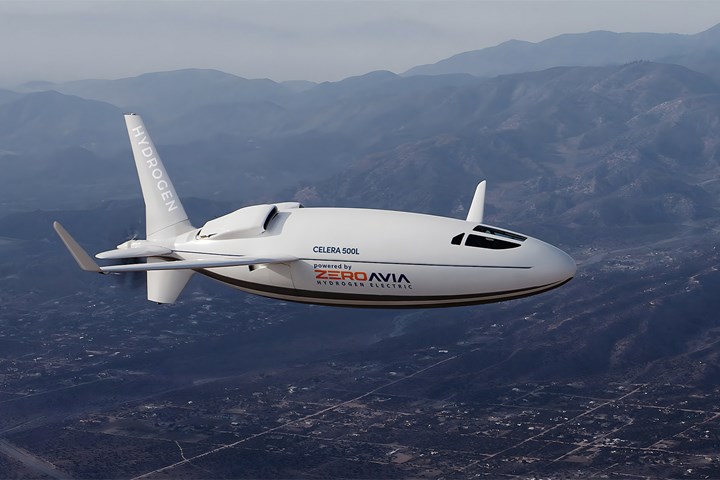ZeroAvia partners with Otto Aviation to deliver new airframe design with hydrogen-electric option
ZeroAvia will optimize the fuel cell-powered electric propulsion systems for Otto’s transcontinental Celera aircraft design, reducing maintenance costs while increasing range.
ZeroAvia (Hollister, Calif., U.S.) has announced a collaboration with Otto Aviation LLC (Yorba Linda, Calif., U.S.) to develop a hydrogen-electric powertrain to power Otto’s Celera aircraft, a new model of transcontinental aircraft that is scalable to 19 passengers. Hydrogen-electric engines use hydrogen in fuel cells to generate electricity, which is then used to power electric motors to turn the aircraft’s propellers, with the only byproduct being water.
Under the agreement, Otto and ZeroAvia will work to integrate ZeroAvia’s ZA600 zero-emission engines to Otto’s Celera aircraft. The collaboration is said to have the potential to make the Celera the first new airframe design to leverage zero-emission propulsion in its launch models.
“ZeroAvia’s hydrogen-electric powertrain helps us to realize the commitment Otto has made to lower operating costs and climate impact for operators” William Otto, CEO of Otto Aviation, says. “Otto is looking to provide the most efficient aircraft in all senses of the word: Minimizing maintenance and operating costs and reducing emissions.”
Otto’s aircraft design is said to offer exceptionally low drag across the entire aircraft. The design of its fuselage, empennage and wings take advantage of laminar flow. Laminar flow is the minimum drag solution for aircraft surfaces and features smooth layers of airflow with little to no mixing of adjacent layers. When coupled with fuel-efficient propulsion systems, like ZeroAvia’s powertrain, the Celera will reduce operating costs — as a result of reduced maintenance costs and falling hydrogen fuel prices — and increase range relative to comparable aircraft, while creating optimal passenger comfort and cargo capacity.
According to Otto Aviation, the Celera design is highly conducive to accommodate large volumes of hydrogen within the fuselage that will enable 1,000 nautical miles of zero-emissions range.
“The majority of our commercial deals to date have focused on retrofit and line-fit for existing airframes, which is essential to deliver zero-emission flight to market as quickly as possible,” Val Miftakhov, ZeroAvia, founder and CEO, notes. “However, efficiency gains from new airframe design can expand the impact of zero-emission aviation. We are pleased to collaborate with innovators, like Otto Aviation, bringing cutting-edge clean sheet designs to market as we can optimize the hydrogen-electric propulsion system for those designs.”
Related Content
-
Plant tour: Middle River Aerostructure Systems, Baltimore, Md., U.S.
The historic Martin Aircraft factory is advancing digitized automation for more sustainable production of composite aerostructures.
-
Infinite Composites: Type V tanks for space, hydrogen, automotive and more
After a decade of proving its linerless, weight-saving composite tanks with NASA and more than 30 aerospace companies, this CryoSphere pioneer is scaling for growth in commercial space and sustainable transportation on Earth.
-
ASCEND program update: Designing next-gen, high-rate auto and aerospace composites
GKN Aerospace, McLaren Automotive and U.K.-based partners share goals and progress aiming at high-rate, Industry 4.0-enabled, sustainable materials and processes.

















